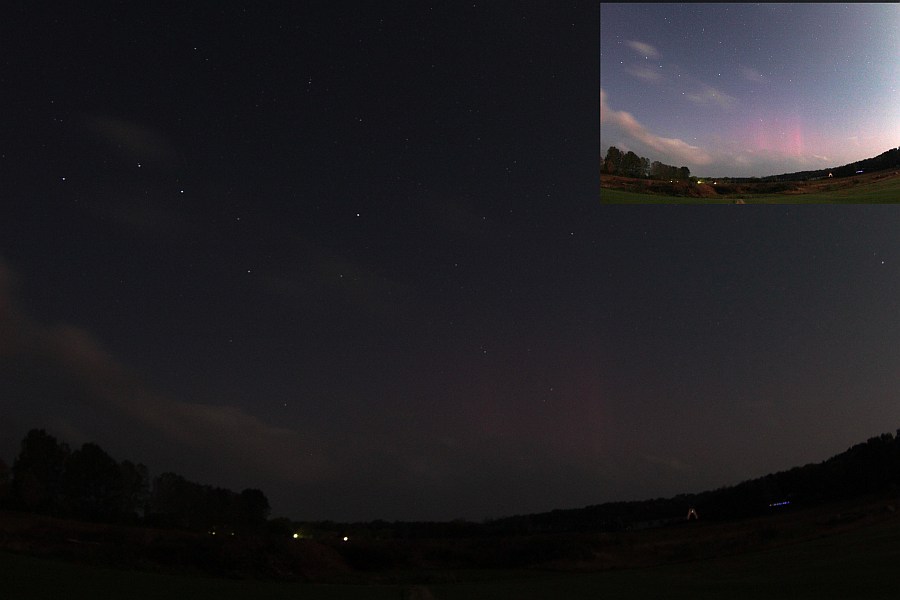
schwache
Strahlen; Azimut = Nordhorizont (N ~ Bildmitte)
21:07
UTC 4/16mm t=8“ CMOS-Sensor 1600ASA Canon EOS 600D, automatischer
Weißabgleich
(eingefügtes
Bild = Autokorrektur in IrfanView)
|
|

schwache
Strahlen; Azimut = Nordhorizont (N ~ Bildmitte)
21:07
UTC 4/16mm t=8“ CMOS-Sensor 1600ASA Canon EOS 600D, automatischer
Weißabgleich
(eingefügtes
Bild = Autokorrektur in IrfanView)
Beobachtungsort:
Rostock-Nordwest (Diedrichshagen / Elmenhorst)
Koordinaten: ca.
54.2°N / 12.0°E
Zu den Ursachen dieses Polarlichtes ging aus Berichten der USAF/NOAA u.a. hervor:
| Auszüge
daraus auf englisch:
Joint
USAF/NOAA Solar Geophysical Activity Report and Forecast
...
... IIB.
Geophysical Activity Forecast: The geomagnetic field is expected
... VI.
Geomagnetic Activity Probabilities 11 Sep-13 Sep
-------------------------------------------------------------------------------------------------------------------------------------------------------------------- Joint
USAF/NOAA Solar Geophysical Activity Report and Forecast
...
IIB.
Geophysical Activity Forecast: The geomagnetic field is expected
... -------------------------------------------------------------------------------------------------------------------------------------------------------------------- Joint
USAF/NOAA Solar Geophysical Activity Report and Forecast
...
... |
K-Indices vom 12.09.14:
| Tromsø / Norwegen: |
|
|
|
|
|
|
|
|
|
|
| Niemegk / Deutschland: |
|
|
|
|
|
|
|
|
|
|
| K-planetarisch: | 5+ | 4+ | 2o |
|
2- | 5o | 5- | 6+ |
K-Indices vom 13.09.14:
| Tromsø / Norwegen: |
|
|
|
|
|
|
|
|
|
|
| Niemegk / Deutschland: |
|
|
|
|
|
|
|
|
|
|
| K-planetarisch: |
|
|
4o | 1+ |
|
|
2+ | 1+ |
Kurzbericht:
Beobachtungsbeginn:
19:50UTC / 21:50MESZ
Beobachtungsende:
21:20UTC / 23:20MESZ
Bedingungen: Die
Durchsicht war grundsätzlich sehr gut. Allerdings ging der abnehmende
Mond auf (mehr als 50 Prozent beleuchtet). Zusätzlich störten
immer wieder tiefe Kumuluswolkenbänke von der Ostsee kommend, speziell
im Sektor NNW-N bis teils ca. 15 Grad Höhe.
Auch die photographischen
Bedingungen am Beobachtungsstandort waren somit durch zunehmendes Streulicht
vom Mond und der horizontnahen Wolkenbedeckung beeinträchtigt.
Diese Sichtung konnte
"nur" als photographisches Polarlicht festgehalten werden.
zurück zu "Aurora Borealis"
zurück zur Homepage
"Atmosphärisches"
![]()
Photographs and
text are copyright ©2014 Olaf SQUARRA
Zurück zum Seitenanfang / "Atmosphärisches" http://3sky.de